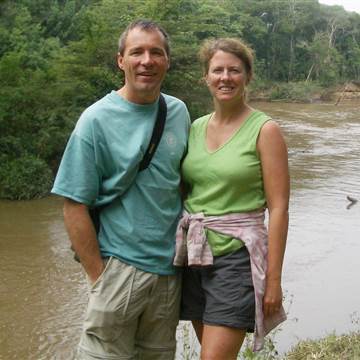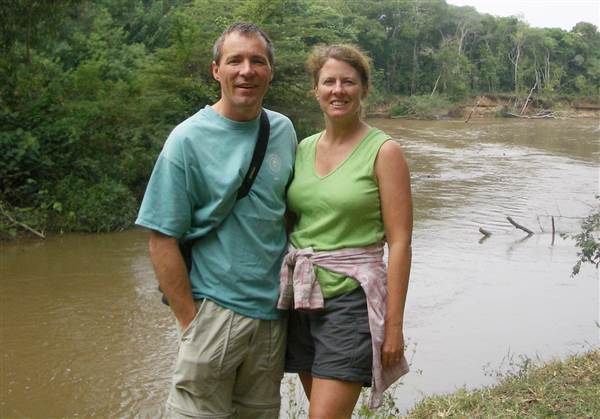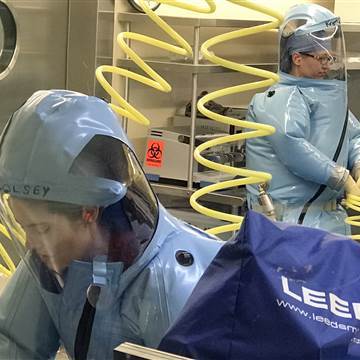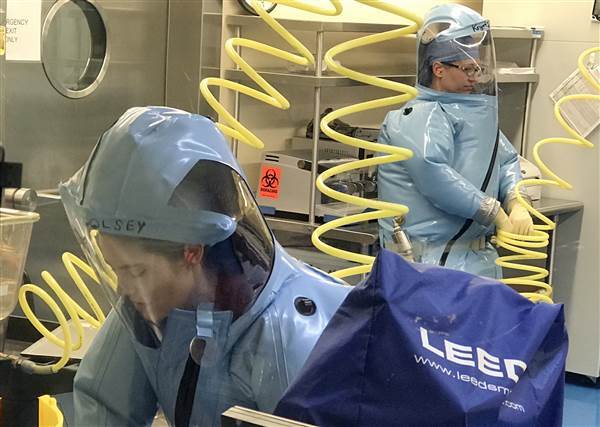The trip to the bat cave was just a filler, a way to kill time while the more interesting attractions in the Uganda jungle, the gorillas and chimpanzees, were snoozing away in the heat of the day.
Michelle Barnes brought back more than memories from that trip. She came home infected with Marburg virus — a cousin of Ebola that’s even deadlier.


Now Barnes’ blood has provided a potential cure for the infection. Researchers at Vanderbilt University and Mapp Biopharmaceutical Inc. isolated an especially potent immune system protein called a monoclonal antibody from Barnes and have used it to cure monkeys infected not only with Marburg virus, but with a related virus called Ravn.
They are working to find ways to mass-produce the antibody and test it in people.
“These viruses are going to come -. Travel bans are not going to stop them.”
The hope is to have supplies ready in case of outbreaks of viruses like Marburg and Ebola, which killed more than 11,000 people and sickened 28,000 in a 2014-2016 epidemic in West Africa.
The research — paid for in part by the National Institutes of Health and the Biomedical Advanced Research and Development Authority, part of the Health and Human Services Department — is a solid example of why the federal government needs to fund experiments that may not seem to have immediate application, Barnes says.
“I always worry about the funding,” Barnes told NBC News.
“These viruses don’t care about borders. These viruses are going to come -. Travel bans are not going to stop them,” she said.
Barnes did not even guess she was infected at first. She and her husband returned home to Colorado just after New Year’s in 2008.
“I was just tired,” said Barnes, a business executive in Golden, Colorado. “But then it came on painfully fast.”
Marburg, like Ebola, causes hemorrhagic fever. “Over the course of five days I went from feeling like I had jet lag to multiple organ failure,” Barnes said.
Doctors tested her for every possible virus — including Ebola and Marburg — but the tests came back negative.
They dosed Barnes with antibiotics and filled her veins with saline to replace the fluids lost to violent vomiting and sweating. They removed her gall bladder when it failed.
“It’s a horrible disease,” Barnes said. “It just keeps shutting down your system.”
And then, her body fought back. It took weeks, but Barnes recovered. She had no idea what she’d had until a few months later, when a Dutch tourist who had visited the same cave died of Marburg.
Related: Biothreats are Real and We’re Not Ready
The World Health Organization sent a team to the cave and found the bats in it were carriers of the virus, which kills 80 percent of its victims. Barnes saw the coverage and asked to be re-tested, and the Centers for Disease Control and Prevention tested samples of blood taken from when she had been ill.
They found the Marburg in her blood this time. When James Crowe of Vanderbilt University heard about her case, he asked if she would consider donating some blood for study.
Barnes was delighted to. “If somebody needed to get Marburg virus so you could donate your cells for research, I am glad it was me,” she said. “I happen to have really good immunity.”
Related: Ebola Drug ZMapp Gets FDA Fast Track
Crowe collaborated with Mapp and a team at the University of Texas Medical Branch to make and test a monoclonal antibody from Barnes’s blood.


Mapp Biopharmaceutical made ZMapp, the cocktail of three antibodies designed to fight Ebola. It was the drug the company raced to produce in time to help victims of the epidemic, but in the end, there was only a small amount and only a handful of people, including the most high profile U.S. survivors of the virus, ended up getting the drug.
By the time the company could produce enough to test, the epidemic was almost over and field tests were inconclusive.
“I think we learned from that outbreak that we were not prepared,” said UTMB’s Thomas Geisbert, who led tests of MR191-N, the antibody taken from Barnes.
In a study published this past week in the journal Science Translational Medicine, Geisbert and colleagues report it cured five monkeys dosed five days after being infected with a virus called Ravn, and four out of five monkeys infected with a Marburg strain.
“If somebody needed to get Marburg virus so you could donate your cells for research, I am glad it was me.”
The monkeys were not treated right away because, Geisbert says, they wanted to simulate what would happen in real life. People infected with Marburg wouldn’t realize how ill they were until they had severe infections.
“We are trying to model the worst thing that would happen,” he said.
Labs are also working on Ebola vaccines, but Geisbert says it’s important to have treatments, too. During the Ebola epidemic, people feared hospitals and were also reluctant to go because they knew there was no effective treatment.
“If you had things like ZMapp or in this case the anti-Marburg MR191 monoclonal antibody available, there would be an incentive for people to show up earlier to get effective treatment,” Geisbert said. “Those infected people would then be less likely to be transmitting the virus to their family and friends.”
Larry Zeitlin, president of Mapp Biopharmaceutical Inc., says he’s trying to come up with the most effective antibody and then the quickest way to make it. The ultimate goal would be a modular production system, where makers could swap in antibodies against whatever…






